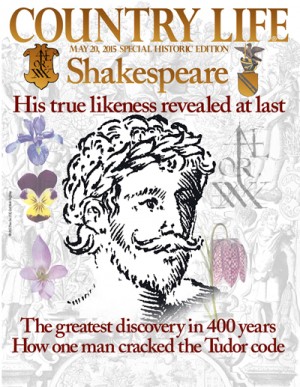 A great deal of fuss has been made about a supposed ‘newly discovered portrait of Shakespeare’ found on the title page engraving of sixteenth century botany book. The editor of UK lifestyle magazine Country Life, in which the discovery was announced, declared it “The Literary Discovery of the Century”. The story was dutifully picked up by BBC News Online and such is the clout of the BBC that by yesterday all major news outlets were excitedly repeating the story, leading it to trend across social media. The botanist who made the discovery quickly morphed into a ‘historian’ and NBC news even multiplied him into ‘historians’ to add a little weight to the theory.
A great deal of fuss has been made about a supposed ‘newly discovered portrait of Shakespeare’ found on the title page engraving of sixteenth century botany book. The editor of UK lifestyle magazine Country Life, in which the discovery was announced, declared it “The Literary Discovery of the Century”. The story was dutifully picked up by BBC News Online and such is the clout of the BBC that by yesterday all major news outlets were excitedly repeating the story, leading it to trend across social media. The botanist who made the discovery quickly morphed into a ‘historian’ and NBC news even multiplied him into ‘historians’ to add a little weight to the theory.
But the portrait is not a portrait of Shakespeare. There were one or two knowledgeable people explaining in the comments sections of various news items yesterday who it was and why, but since their explanations seem to have been drowned out by a slew of ‘hipster facial hair’ comments and breathless speculation, I thought I’d set them down here, in the hope that the madness might be stopped.
The engraving, on the frontispiece of John Gerard’s The Herbal or General History of Plants is a representation of Dioscorides, a Greek doctor from the time of the Roman emperor Nero. His book on herbal medicine had been the standard text on the subject for 1,500 years. In other words, he was considered something of an authority on the subject of the book, and was depicted there to give it his seal of approval. For being the top writer in his subject, he gets a laurel wreath on his head. For those who are arguing that the laurel crown suggests the subject is a poet (which now, includes, disappointingly, Stanley Wells), you didn’t have to be a poet to be depicted with a crown of bay laurel. You just had to be so good at something that your name might live forever. Here is Francis 1 of France, not a poet. Here is the ‘Meistersinger’, a master singer but not a poet. What a laurel wreath symobolises in this wider sense is the Crown of Immortality, which Dioscorides had earned through writing a book that helped him cheat physical death by keeping his name alive for one and a half millenia. The Roman army toga is a bit of a clue, for Dioscorides was a physician in the Roman army. Why Shakespeare would be depicted in a toga is anyone’s guess. Yes of course, this is how an Elizabethan actor might have been dressed in a Roman play. But we have no evidence that Shakespeare was ever seen on stage in a toga, and since many other actors were seen in togas, this would hardly identify him as Shakespeare. If you want to do that, at least put a quill in his hand.
We can be sure that the picture is meant to be Dioscorides because when the book was updated and reprinted in 1633, he was helpfully labelled. You can compare the two images for yourself. Here he is (lower right hand figure) in the first edition of 1597. And here is the same guy — same facial hair, same toga, same footwear — as the lower right hand figure in the second edition of 1633, on a plinth that says ‘Dioscorides’. Just in case someone thought he was Shakespeare, or Francis Drake, or someone else with a fancy moustache.
Country Life’s gardening expert, Mark Griffiths, makes a great deal of the fact that in the first edition the figure is holding a snake’s head fritillary. In Ovid’s version of the story which Shakespeare used for his long poem Venus and Adonis, Adonis was transformed into an anemone. Shakespeare referred to the flower only as ‘the purple flower… chequr’d with white’, which one scholar has suggested might be either a fritillary or a variegated tulip. But just because Shakespeare (possibly) referred to a fritillary, and even if he was the only poet of the period to do so, that doesn’t make any chap holding a fritillary into Shakespeare. And here’s something else. It was only in 2014 that anyone suggested that Shakespeare’s ‘purple flower… chequr’d with white’ was a fritillary.(1) We have no evidence that a single Elizabethan, or anyone before Miriam Jacobson, ever made that connection. We have no evidence that Gerard ever read Venus and Adonis. Nor has any plausible explanation been offered as to why Gerard would depict Shakespeare on the cover of his Herbal. Shakespeare wasn’t even particularly famous in 1597. Two long poems had been published with his name upon them, but the only Shakespeare plays that had been published (including Titus Andronicus) had been published anonymously. Plays at this time, like films now, were strongly associated with their playing companies: the actors who acted in them. Until his name began appearing on plays the following year, only business insiders and other writers would be likely to know who had written the plays we now know as Shakespeare’s.
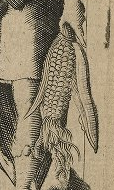 Griffiths claims that the maize (corn on the cob) in the figure’s other hand is a reference to Titus Andronicus. But the ‘corn’ mentioned in Titus Andronicus is very clearly wheat, not the newly imported American plant maize. We know it is wheat because it is thrashed (“first thrash the corn, then burn the straw” – 2.3.123) and gathered into sheaves (“This scattered corn into one mutual sheaf” – 5.3.70). You do not do this with corn on the cob. ‘Corn’ in Elizabethan England denoted any kind of grain, and according to the Oxford English Dictionary, maize was not referred to as ‘corn’ without a modifier (in the early days ‘Turkey’, and later ‘Indian’) before 1809. For those who are struggling with the difference, here is wheat, the ‘corn’ in Titus Andronicus, the type that can be thrashed and gathered into sheaves.
Griffiths claims that the maize (corn on the cob) in the figure’s other hand is a reference to Titus Andronicus. But the ‘corn’ mentioned in Titus Andronicus is very clearly wheat, not the newly imported American plant maize. We know it is wheat because it is thrashed (“first thrash the corn, then burn the straw” – 2.3.123) and gathered into sheaves (“This scattered corn into one mutual sheaf” – 5.3.70). You do not do this with corn on the cob. ‘Corn’ in Elizabethan England denoted any kind of grain, and according to the Oxford English Dictionary, maize was not referred to as ‘corn’ without a modifier (in the early days ‘Turkey’, and later ‘Indian’) before 1809. For those who are struggling with the difference, here is wheat, the ‘corn’ in Titus Andronicus, the type that can be thrashed and gathered into sheaves.
Here is maize, known to Elizabethans ‘Indian corn’ and in this book, Gerard’s Herbal, as ‘Turkey corn’: one large head of which the figure on the lower right (‘Shakespeare’/Dioscorides) is holding in his hand.
The ‘corn’ in Shakespeare’s Titus Andronicus is the first kind, not the second kind. Shakespeare did not write about the second kind (maize) in his works. This removes any argument that it might be Shakespeare who is holding the maize.
The frontispiece show Dioscorides holding these new plants to make that point that Gerard’s book is bang up to date. The picture represents the ancient authority (Dioscorides) being updated with Gerard’s new knowledge. It is an attempt to establish Gerard as the new authority in the subject.
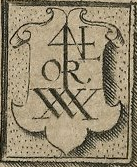 Now to the key part of the new claim; the peculiar ‘cipher’ written on the plinth underneath the figure, which Griffiths ‘decoded’ to arrive at Shakespeare. He sees the first part as a 4 (and also as an arrowhead) (with an ‘E’ stuck to it ). Quoting the Guardian article:
Now to the key part of the new claim; the peculiar ‘cipher’ written on the plinth underneath the figure, which Griffiths ‘decoded’ to arrive at Shakespeare. He sees the first part as a 4 (and also as an arrowhead) (with an ‘E’ stuck to it ). Quoting the Guardian article:
“In Elizabethan times, people would have used the Latin word “quater” as a slang term for a four in dice and cards. Put an e on the end and it becomes quatere, which is the infinitive of the Latin verb quatior, meaning shake. Look closely and the four can be seen as a spear.”
Look closely and you can see almost anything you want to see. In the fascinating world of the Shakespeare authorship question, I witness this kind of thing all the time. Griffiths says the ‘Or’ is because the Shakespeare family had recently been granted a coat of arms with a gold background and the heraldic term for gold is ‘Or’. Below that, he sees a ‘W’ for ‘William’.Case closed!
But this ‘cipher’ was in fact a ‘printer’s mark’ signifying ‘Nortons’. It was noted as the mark of William and John Norton in the 1749 book, Typographical Antiquities. Printer’s marks like this were a standard device of the period, as you can see from this frontispiece on the British Museum Website. And although William Norton was dead by 1597, John Norton (William’s nephew and apprentice) was the printer of the book and as as Griffiths points out ‘the venture was primarily John’s… the [financial] risk was chiefly his’.(2) The Nortons has used a number of different printers marks. Mark Griffiths, defending his ‘decode’ of this mark, lists some known ones here. But none of these elaborate ones would have fitted into the small space available on the plinth. Thus they have opted for an ‘rebus’, a common Elizabethan device that works on the principle of our modern gameshow Catchphrase: ‘say what you see’. An ‘N’ is clearly visible at the top of the device, an ‘OR’ in the middle, and below this, three interlocking ‘X’s: Roman tens; very appropriate given that the figure standing on this plinth is in Roman toga. So say what you see, and the answer to this rebus is ‘NOR’-tens, the normal pronunciation of ‘Nortons’.
Griffiths believes the ‘OR’ of Norton indicates the heraldic gold on Shakespeare’s coat of arms. But many people had gold in their coat of arms. One can only use this to support an answer one has already determined: it is not a necessary part of the puzzle if it is not needed to derive the answer. Similarly, he sees ‘W’ in the lower row, but has no explanation for the multiple crosses. More than that, he does not explain why, if this device is a ‘cipher’ for ‘W Shakespeare’, it needs to be in cipher at all. Why the secret code? Why not ‘Wm. Sh.’? No wonder certain Oxfordians are jumping upon this with glee. And they, of course, are ‘decoding’ the cipher entirely differently, as (not suprisingly) Edward de Vere. For them, the turkey corn (they at least realise there is no maize in Titus Andronicus) is because Vere has ‘turned Turk’ and that the ‘cipher’ contains the words ‘ADON’ and ‘Oxenford’ and ‘EARL’ and the three Ws of ‘Vere Vero nil Verius’ (Vere’s motto) and a ‘shaken speare’ (for the pen name). Clearly, if you have a definite candidate in mind, you can see what you want to see. But if you say what you see, in the tradition of an Elizabethan rebus, you will say ‘NOR-tens’.
What Griffiths correctly identifies as a ‘sign of four‘ but then reads as a both the source of the Latin for ‘shake’ and a depiction of a spear is a traditional element of a merchant’s mark. If you read what is attached to it as an ‘E’ then, suggests Barry Clarke, this might be an E for Elizabeth. John Norton was the queen’s printer according to Henry Lamoines’ Typographical Antiquities (1797, p.75):
There is no documented connection between Shakespeare and Gerard. There is no plausible reason why Gerard would feature Shakespeare (at that time, author of two narrative poems, but not a famous playwright) on the front of his botany book. No explanation as to why he would need to turn the poet’s name into a cipher. And no reason on earth why he would dress him in a toga and depict him carrying a piece of corn on the cob. And even if it were Shakespeare, which it isn’t, where is the evidence for the claim that this depiction is ‘drawn from life’? Nothing about this cartoonish sketch suggests such a thing.
In short, then, as with so many Shakespeare news items that cause near-hysteria in the mainstream media, this is much ado about nothing. It is possible that the story already has enough momentum to become a new ‘truth’, and that future Shakespeare news items will appear under a picture of the Greek physician Dioscorides just as many, thanks to the last of these ‘newly discovered picture of Shakespeare’ stories, now appear under a picture of Sir Thomas Overbury. But I sincerely hope not.
Credit is due to many sources for the information in this article, chiefly Guardian commenter James Wallace (‘MisterJim’), John Overholt, Miriam Jacobson, Tom Reedy, and Barry Clarke.
Versions:
* 21 May 2015 – Original article
* 23 May 2015 – updated and expanded after feedback from Julie Sandys Bianchi and correspondence from Barry Clarke regarding the rebus solution for the printer’s mark.
* 25 May 2015 – updated with further information from Barry Clarke, and section on the Crown of Immortality.
Footnotes
(1) In Miriam Jacobson’s Barbarous Antiquity: Reorienting the Past in the Poetry of Early Modern England
(2) http://www.countrylife.co.uk/features/the-true-face-of-shakespeare-further-evidence-of-its-authenticity-72418 accessed May 21 2015.
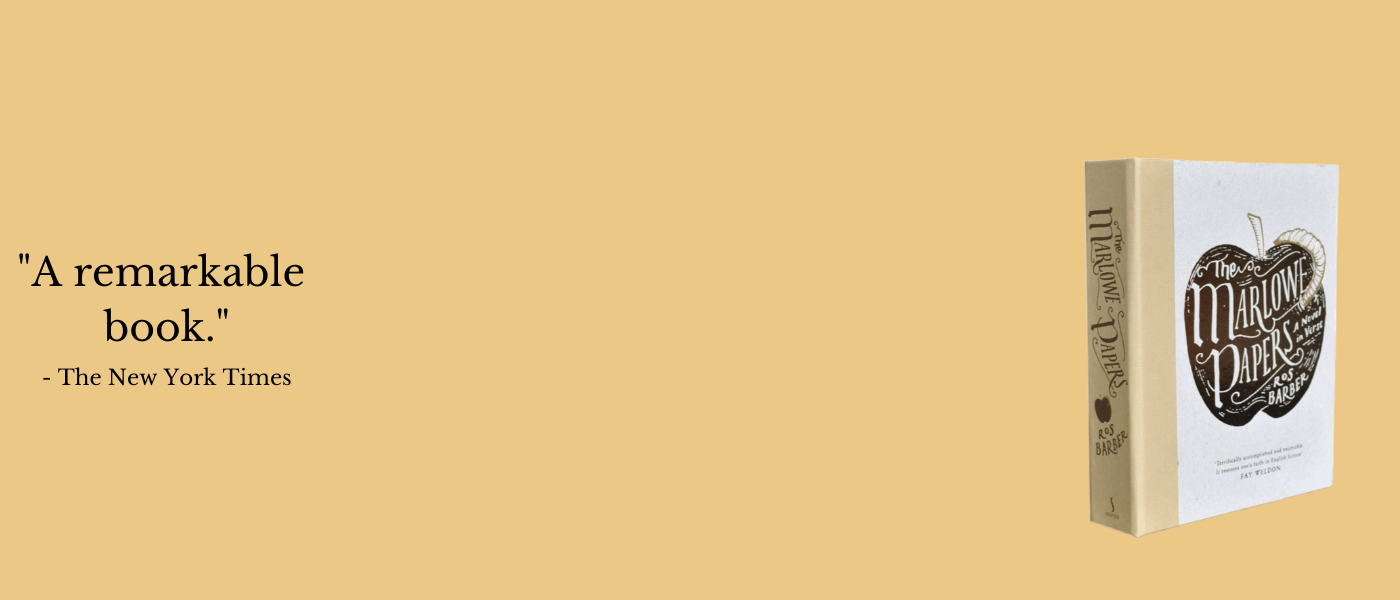
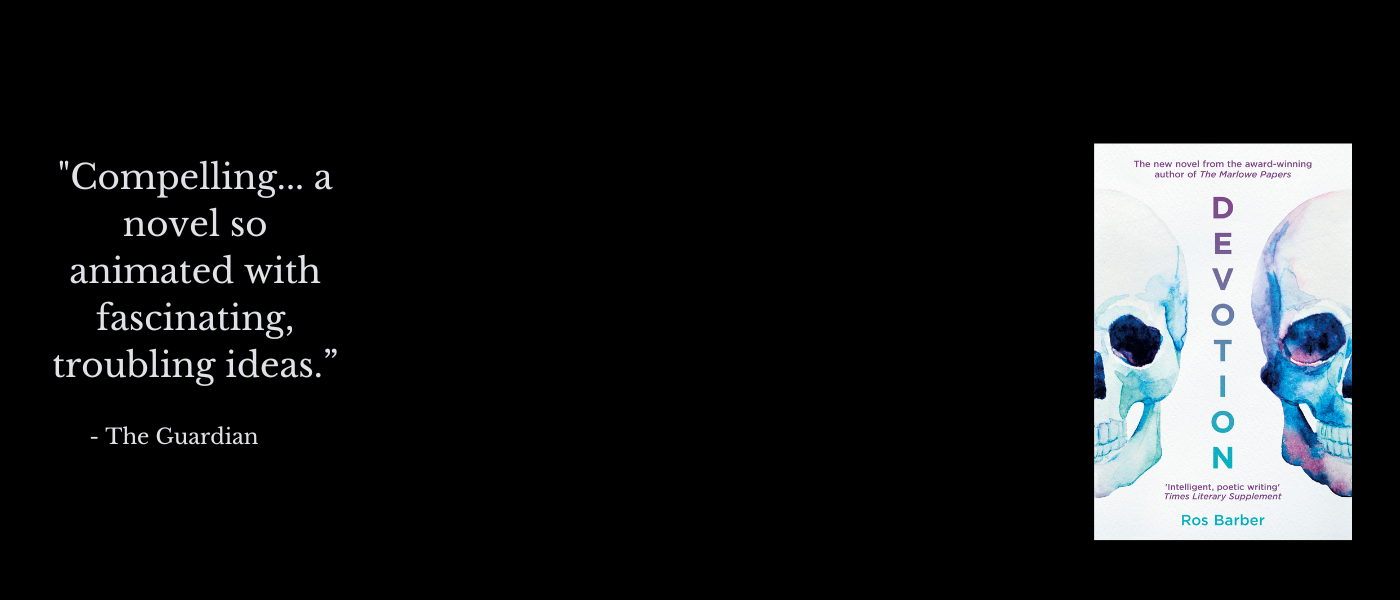
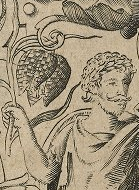
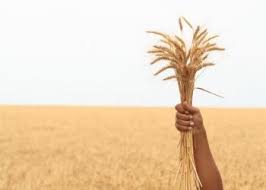

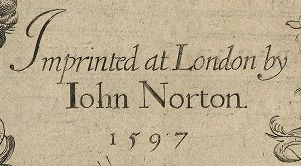
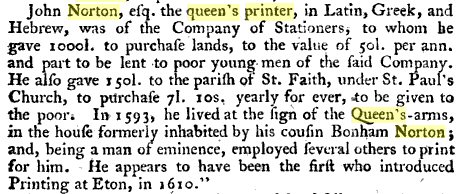
An addendum from ‘Mr Jim’ (why did I choose that name for the Guardian website?):
I think we can also identify all four figures correctly now, using the same labelled figures portrayed on the title page of Gerard’s source, the 1583 Latin translation of Dodoens’ book on the subject, which was also reused by the same printer for his editions of Clusius in 1601 and Dodoens again in 1616.
Here’s a link to the Clusius frontispiece with an explanation of its re-use – http://botany.edwardworthlibrary.ie/herbals/seventeenth-century/carolus-clusius/
So, forget portrayals of Gerard, Dodoens, Burghley and Shakespeare. Top left is Adam, reworked with spade to delve in Gerard. Top right is Solomon (Salomon) – both frontispieces have him with clasped book. Bottom left is Theophrastus – with the same style hat in both. And bottom left on the Plantin engraving is Dioscorides, with armour on his leg and in a tunic, enough to signify the famous botanist in the Roman army.
The article above mentions that the same woodcuts of plants were used in all three. Though Norton has employed William Rogers to come up with a new engraving that displays new plants not found in Dodoens, it is not surprising that Rogers then draws on this image from the source of the rest of the book.
This is surely a far simpler explanation for the identities of all four men than Country Life provides.
Ah, brilliant! Thanks for getting in touch, James, and for giving me your real name so that I can credit you correctly. Fine work indeed!
I suppose it matters little after the passage of time, given that this little tempest has disappeared without a ripple, but the Roman in the lower right corner is the poet Martialis. On page 123 of the 1597 Herball, as part of discussion of the Fritillary the figure is holding, Martialis is quoted as naming the flower “frittillus”. An epigram by Martialis follows.
The problem with ‘Jim’s’ analysis is that Dioscorides is not holding the symbols that in Gerard’s book are associated with Adonis – the corn and the fritillery. Griffiths deals admirably with the comparison between Soloman, Theophrastus and Dioscorides in his article. It seems to me that Jim has not read it. The point that is being made is that Dodoens, Gerard and Burghley are garbed as these figures. We should be cautious of reading anything by the Elizabethans as having only one meaning. Griffiths connections to Burghley, Dodoens and Gerard are very cleverly worked and need careful point-by-point rebuttal. He did not overlook anything that Jim has said, but his research, by sheer weight of evidence, overrides it.
Saying that the figures on Gerard’ book are THE SAME “as the labelled figures portrayed on the title page of Gerard’s source, the 1583 Latin translation of Dodoens’ book on the subject, which was also reused by the same printer for his editions of Clusius in 1601 and Dodoens again in 1616” isn’t entirely true. The figure in the lower left in the Herball print does not resemble any of the labeled figures in the other books . . . certainly not the Theophrastus in Clusius. And while the image of Dioscorides in the 1633 book is similar to the one pictured in the lower left, it had the advantage of using the figure pictured in 1597 as its model. So although I understand that the figure Griffiths identified as Shakespeare could be identified as Dioscorides, and only Dioscorides, there are other indications in the 1597 print that, as with many Elizabethan frontispieces there are puns and hidden meanings embedded in the design. Roger’s 1597 engraving features several human figures clad ambiguously whose identities can be distinguished through the architectural and botanical symbols surrounding them and at the very least because scholarly readers can find conflicting hidden meanings and ambiguity in the physical features and attire of the figures, that the scholarly dissension alone is a good indication that hidden meanings exist. The engraving wasn’t designed just to be pretty, but to engage the reader and prompt reflection.
Corn is pictured in the engraving but not named as such, so your complaint that the word reference is anachronistic makes no sense to me. The artist may not have had a name for the grain but clearly had seen it since maize reportedly was brought to Western Europe by Columbus. The symbol of the grain is linked to the constellation Virgo which was the extraterrestrial landing place of Astraea, per “English Renaissance Drama: A Very Brief Introduction to Theatre and Theatres …” By C. W. R. D. Moseley p. 38
An arrow shot from a bow is referred to as Astraea in ACT 4 Scene 3 by the title character in Titus Andronicus “Terras Astraea reliquit:” (Astraea has left the earth.) In the symbolic picturing of the corn cob in the poet’s hand, it could be interpreted as an encoded reference to something which only readers familiar with the writing of Virgil and the text of Titus Andronicus would recognize.
Also, what appears to be a simple printer’s mark also prompts debate. Many researchers report having seen no evidence that John Norton was ever a printer himself* and that the printer’s mark used in the Herball title page bears no resemblance to any known Norton family published works. As an Oxfordian, I can look at that symbol and see a cipher for the name Lord Oxford and along with that I can see an arrow spearing up to the man featured standing on the plinth. As someone who likes puzzles, I can also see John Norton’s name. But neither interpretation precludes the other from being correct.
*Example from “The Business of Books: Booksellers and the English Book Trade 1450-1850” By James Raven p.40
“Among other leading book trade capitalists of the day, the Norton family was headed by William (trading 2562-93), his son, Bonham (1565-1635, trading from 1594, and Master of the Stationer’s Company in 1613, 1626 and 1629), and William’s nephew John (1557-1612, trading in St Paul’s Churchyard 1586-7, in Edinburgh, 1587-96, and in Churchyard again thereafter). John Norton, NEVER A PRINTER, accumulated great wealth, with lands in Shropshire…”
Julie, thank you so much for your observations. They are very helpful and I have responded to some of them in this newer version of my article. The article was written in somewhat of an impatient rush the other morning (I have a huge pile of marking and am in the final stages of finishing a book) when my irritation about the fuss this ‘discovery’ is causing got the better of my general wish to stay focused and prioritise appropriately! But it is now a more complete piece, thanks to you pointing out some of your difficulties. With the corn, for example, I have now included pictures so you can see that corn on the cob (which the figure is holding) is entirely different plant to the one mentioned in Titus Andronicus, therefore does not provide a link to Shakespeare. The corn on the cob is there not ‘as an encoded reference to something which only readers familiar with the writing of Virgil and the text of Titus Andronicus would understand’ (there is no corn on the cob in Titus Andronicus) but because Gerard was writing about corn on the cob (Turkey Corn/maize)… and indeed the Fritillary… for the first time, thus updating the previous authority, Dioscorides.
Those who report ‘having seen no evidence that John Norton was ever a Printer himself’ are wilfully blind or have not see Gerard’s 1597 herbal, since this very frontispiece we are discussing feature very prominently the words ‘Imprinted at London by John Norton’.It should not surprise you to learn, as an Oxfordians, that academics can sometimes get things wrong. I would personally always trust a primary source (like the text on this title page) over a secondary source (like James Raven’s book, written over 400 years later).
As to the multiple possible ways of interpreting the cipher, I would always goes for the simplest, and that, to my mind, is ‘NOR-tens’. The fact it’s not used elsewhere doesn’t matter – it’s clear that the Norton family used multiple marks and here they needed one that fitted the very limited space. Naturally you will see what you want to see, but that is danger of having made up one’s mind on the authorship question, which is why I prefer to leave possibilities open. If you feel I have failed to answer any of your objections in this new version of the article, of course do let me know. Thanks again for your comment.
Here’s an update on the printer’s mark debate: On the website arthistorynews.com, Dr. Alexander Marr of the University of Cambridge has pointed out that compared with the mysterious mark on the plinth at the feet of the mystery man there is a nearly identical wool merchant’s mark on a sack portrayed in the background of the circa 1560 “Judde Memorial” painting. And the resemblance is remarkable. But if you already weren’t aware, I’m sure you’d like to know that the Judde family in the picture were residents of Great Canfield Essex, where the Lord of the Manor was the 16th Earl of Oxford, John de Vere.
Thanks Julie. Unfortunately it’s not ‘nearly identical’ (though it has a couple of similarities, as do some other marks), but what it *does do* is further strengthen the ‘merchants mark’ idea. Printers were merchants too. This is no code. The fact that the Judde family were residents of a place where the Lord of the manor was a de Vere doesn’t mean anything unless you are an Oxfordian fishing for links. You’ll find these marks in all sorts of places that have no links to de Veres. These marks were common. Now, if the marks were actually identical, and you could show that the mark in the Judd painting [signified / was used by ] the de Vere family, maybe you’d be on to something. Better, surely, to read the whole article on arthistorynews.com and take in what the experts in art history are saying. The whole thing is a crock. Don’t be taken in.
Ros, a small correction (if I may) to what you have written: you say “maize was not referred to as ‘corn’ without the modifier ‘Indian’ before 1809” Actually Gerard calls it “Turkie Corne” in his 1633 edition of ‘Herball’, Dodoens also calls it “Turkie corne” in his ‘nieve herball’ (1578)and so does Estienne (1616). You are quite right when you say ‘corn in Elizabethan England denoted any kind of grain.’ Maize is a grain and therefore qualifies as ‘corn’ – they called it ‘Turkie corne’ we call it ‘sweet corn’. The god of Corn, Adonis, famed for his lovely garden, is also represented in the engraving by a ‘narcissus lily’ which grew from his spilled blood in Shakespeare’s ‘Venus and Adonis’. The figure is dressed the same as contemporary pictures of Adonis. Since Shakespeare was called ‘Adon’ three years earlier by Thomas Edwards and since the other three figures have been convincingly shown to represent real people who were instrumental in helping the book along, we should be asking ourselves, what the poet ‘Adon’ is doing among them. I agree entirely with you that you can read almost anything you want into the cryptogram, those who wish to view it only as a printer’s mark and nothing else are at liberty to do so; those who believe that (like the figures in fancy dress upon their plinths) it too contains a double meaning are also at liberty to do so. Since the equivalent mark on the Burghley plinth points to Burghley, I am inclined to believe that the ‘printer’s mark’ also contains (as well as “Nortens”) clues to the identity of the ‘Adon poet’ standing above it. In fact it is not difficult to find the word ‘ADON’ in it. Finding these clues adn double meanings would have been as easy for people in 1597 as it is for us in 2015 – the glory of it all is that we can take what we want and leave what displeases – Oh to have been an Elizabethan! My warmest regards, AW
Hi Ros,
The Rebus is not derived from the Norton printer’s mark. In fact, it’s derived from the merchant’s mark used by the wool trade. You can see it on the Judde Portrait from 1560 on a pair of woolsacks in that painting. The wool mark has been flipped on its vertical axis in order to put the cross on the right, where it is slightly transformed into the letter “E.”
The rebus thus reads – Wool+E. The OED defined the word “burl” as a “tufte of wool” – ergo the rebus is “Burl+E” or Burghley – the dedicatee of the book. This solution is logical, simple and elegant. You can read more at my blog, thefestivalrobe.com.
Best Regards,
Chris Carolan
I didn’t say it was derived from the Norton printer’s mark. I said it IS the Norton printer’s mark. See my answer elsewhere in the comments section on this in relation to merchants’ marks generally and the merchant’s mark in the Judde portrait in particular. They are not to my mind the same mark. This one does not read WOOL+E, it reads NOR+XXX(tens). Although if I were you, no doubt I would see it exactly as you see it. There’s no point arguing about this. People see what they wish to see. You are welcome to hold an entirely contrary opinion!
It can certainly be both, Ros, and I think that likely. Either way, I think it has ZERO to do with Shakespeare, so we’re in agreement there.
Two facts are important.
1. The Nortons never used this mark in any other book.
2. The mark is closer to the wool merchants mark than any mark the Nortons ever used.
Any solution must explain those two anomalies.
C.
1. It doesn’t matter that they didn’t use it any other book (that you know of / that has survived). Their others were too complex to fit into this small space.
2. The mark is closer to standard merchant mark, such as PRINTER’s marks, than any other (known/extant) mark the Nortons used. Again, the small space available on the plinth is a perfectly good explanation for this. Lots of printers used marks much like this one. No reasons why the Nortons – who used many different marks – wouldn’t use one like this where the space wouldn’t allow them to be more expansive/decorative.
Hi Chris, I didn’t say this rebus was derived from the Norton printer’s mark. I said it *is* the Norton printer’s mark. See my other answer in the comments here for the relationship of this merchant’s mark to other merchants’ marks and specifically the wool merchant’s mark in the Judde portrait. I see no similarity between them. You might read the other one as WOOL+E but this has rather clearly NOR and then three roman TENS – too much of a coincidence for a book published by one of the NORtons, surely. Of course, if I were you, I would read it as you read it. That’s why there’s no point arguing about this. People see what they want to see.
The cipher contains every letter in ‘William’, ‘John’, and ‘Norton’. The letter at the top right is not E (as per Griffiths); it is L. The I (which Griffiths does not find) is the vertical line in the middle from the top to the top of the W-M combination.
Good observations. I can’t see all of these letters (yet) – the H for example? I, too, thought Griffiths’ ‘E’ was actually an L.
I posted a mock-up of the individual letters at https://noodlework.wordpress.com/2015/05/26/nortons-printer-cipher/
HTH
Very nice indeed, thanks for this!
You’re quite welcome! And many thanks for your blog posting!
Does anyone know why Mr. Griffiths is suggesting the lower right figure is Shakespeare? Based on the 1633 title page, the figures on the 1597 title page (clockwise from upper left) are: Ceres (the Roman goddess of agriculture), Pomona (the Roman goddess of fruit and nut trees), Dioscorides (a Greek botanist), and Theophrastus (the Greek “father of botany”).
How is Shakespeare related to botany? And why would anyone in 1597 associate him with such field?
Griffiths makes very detailed arguments answering both your points in his 20-page article in country life. He comes up with entirely different identities for these figures on the 1597 edition (based largely on ‘the language of flowers). His arguments for the lower right figure being Shakespeare are chiefly those I have outlined in this piece – 1) that the printer’s mark is a code for ‘W Shakespeare’ 2) that the ‘OR’ is to reference the gold in his coat of arms and 3) that he is holding corn (which is mentioned in Titus Andronicus, although in fact that is wheat and what he is holding is maize) and a snakeshead fritillary (which a scholar in 2012 thought was the ‘purple flower chequered with white’ that Shakespeare has spring from the blood of Adonis, instead of the anemone of the original). Shakespeare is not related to botany, except that, like many writers, he sometimes mentions plants. Griffiths has his own answers for this question too, but not ones that are, to my mind, at all plausible.
Thank you , Ros